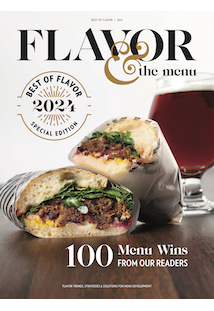


Shereen Abutom
Senior Culinary Innovation Manager
Del Taco Restaurants
Kitchen Collaborative is a recipe-development initiative formed by Summit F&B and Flavor & The Menu. To fuel flavor innovation, a group of talented chefs partnered with sponsor brands and commodity boards to create recipes that showcase the passion and potential of our industry.
For Shereen Abutom, Senior Culinary Innovation Manager, Del Taco Restaurants, a project like Kitchen Collaborative is an opportunity to lean into her roots, while exploring new cuisines and flavor profiles. “A key source of culinary inspiration for me is to start with familiar ingredients, but take them to new territories,” says Abutom.
“The Mushroom Falafel Burger is a good example,” she continues. “It’s a dish I grew up eating, and with the addition of a few non-traditional ingredients, it goes into a completely different, but recognizable flavor profile.” The Watermelon Fattoush pays similar homage to childhood memories, while the Chile Verde Seafood Posole takes its direction from Abutom’s professional background in Mexican cuisine. What ties all three dishes together is her fundamental passion for “taking one ingredient and exploring ways to make it a star within multiple recipe categories.”
Chile Verde Seafood Posole
While a traditional Mexican posole usually features pork and chicken, when Abutom was asked to use Bush’s Hominy in a seafood stew, she found the protein substitution worked beautifully in the classic dish. “It’s a natural flavor match,” she says. “This light, fresh stew is great for all seasons.”
In the Chile Verde Seafood Posole, Bush’s White Hominy takes center stage, starring alongside shrimp and either snapper or tilapia. Abutom was deliberate in selecting these particular fish species: “The mild, sweet flavor of snapper and tilapia won’t overpower the shrimp,” she explains. “Plus, their light and flaky texture pairs well with the other ingredients.” These include an array of flavorful components: roasted tomatillos, onions, garlic and peppers (poblano, serrano, jalapeño), along with chicken broth, bay leaves, Mexican oregano, cilantro, parsley, salt and black pepper. Without the fat of pork or chicken, this is a very light dish, Abutom notes, so she added butter to provide a touch of the richness and mouthfeel expected of a posole.
Abutom chose to purée the hominy, a technique that she says, “really allows the corn flavor to shine in this dish.” Overall, she characterizes the build as “fresh, corny, herby, slightly spicy and tangy, with mild seafood flavor.” She suggests a variety of potential accompaniments and garnishes, such as thinly sliced cabbage and radishes, diced red onions, avocado chunks, lime wedges and corn tortillas. “These create fun and different flavor and textural eating experiences with each bite.”
Watermelon Fattoush
The cherished memories of childhood often serve as a catalyst for recipe ideation, with some of the simplest concepts being elevated to restaurant-quality menu stars. For this Watermelon Fattoush, Abutom was inspired by the hot summers of her youth where activity centered on the backyard. “My parents would put out a giant platter of hunks of watermelon, a variety of cheeses, cucumbers, olive oil, za’atar, bread and olives. Without plates or utensils, we would just dig in with our hands—it was glorious!” she reminisces. “After we ate, we would jump in the pool and wash off the sticky watermelon juice.”
Abutom recreates the iconic Levantine salad by featuring watermelon in favor of traditional greens. It’s paired with Persian cucumbers, grape tomatoes, parsley leaves, mint leaves, onions and crumbled feta cheese. It’s dressed with a light mixture of lemon juice, extra-virgin olive oil, sumac, salt and pepper. “Watermelon complements all the other vegetables and herbs in this recipe, especially the cucumbers and tomatoes. Its sweetness tempers the tangy dressing and salty cheese. Watermelon is definitely the star in this recipe,” she says.
Za’atar-seasoned toasted pita chips are served on the side. “Toasted pita chips are usually tossed into the salad, but as the salad sits, the pita soaks up all the delicious dressing,” says Abutom. “This version is more like a chips-and-salsa experience.”
With a few tweaks, the dish can be adjusted to fit many cuisines and categories, says Abutom. Sub queso fresco for the feta and add some green chiles and you have a Mexican-inspired appetizer. “Or spread it on a bed of greens and top it with grilled salmon and you have a delicious main dish. It has so much potential!”
Mushroom Falafel Burger
Asked to demonstrate the versatility of Lee Kum Kee® Chiu Chow Chili Oil by showcasing it in an unconventional application outside of Asian cuisines, Abutom seized on the product’s savory profile to build this uber-umami Mushroom Falafel Burger. “This ingredient was a challenge, because I’ve always used it exclusively in Asian dishes,” admits Abutom. “It’s extremely savory, salty, garlicky and spicy, with umami richness,” making it a terrific complement for the mild garbanzos and cremini-shiitake mushroom blend that are at the heart of her burger, while also adding another layer of umami and delivering a softer, less-crumbly texture.
The dish reflects careful flavor curation: “I love shiitake mushrooms, but I didn’t want them to overpower the whole build. The creminis help mellow out and balance the flavor,” says Abutom. It also shows a nod to kitchen pragmatism: “I decided to simplify the recipe by using canned garbanzo beans rather than starting with dry.” And the chile oil is incorporated in multiple steps: to sauté the mushrooms, to toss with the chickpeas before roasting and to spike a labneh spread used as a condiment in the build.
“This is a spicy dish,” says Abutom. But even with the addition of the oil, “the cold, tangy labneh spread has the effect of cooling down the palate.” The overall effect is “a beany, herby, garlicky, umami-filled burger contrasted by the texture and tartness of accompaniments like the labneh, pickles, lettuce, tomatoes, onion and so on,” she notes.
Project Management: Summit F&B
Photography: Carlos Garcia // Food Styling: Peg Blackley











